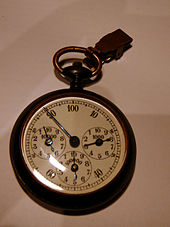Pedometer
A pedometer or step counter is a small mechanical or electronic device used to count steps that the wearer attaches to a belt or waistband. In animals, a pedometer is usually attached to the legs.
The Swiss watchmaker Abraham-Louis Perrelet is considered to be the inventor of the mechanical pedometer . He built his device for the first time in 1780. They had rectangular cases and usually had four dials on the lid, which made it possible to count up to 10,000 steps.
Modern activity trackers and smartphones also contain the "step counter" function.
principle
The steps taken by the wearer are counted and displayed and, if necessary, saved. Since every suitable movement or shock is interpreted by the device as a step, miscounts can more or less easily occur. The accuracy of the count is very variable because of this systematic error.
Modern pedometers also show the net walking time and the distance covered if the average stride length has been determined and entered beforehand. Standing times are not counted and recognized as soon as 1–2 double steps are omitted. Some models also allow an approximate calculation of the energy expenditure, for which the body weight must be entered.
Applications
Often used by hikers and athletes, the pedometer is becoming increasingly important in connection with health prevention . In addition to controlling daily exercise behavior, it is primarily intended to increase awareness of one's own exercise behavior in the area of health prevention and to motivate additional exercise. Its effectiveness was recently proven in a study with the result that the pedometer can motivate people to move more and thereby reduce the risk of cardiovascular diseases . For every additional 2,000 steps per day, the risk of cardiovascular events can be reduced by 8 percent.
In agriculture , it is used in dairy farming in order to be able to draw conclusions about the activity of the animals from the measured number of steps and thus to obtain additional information about the animals' oestrus cycle . The pedometer is tied above the claw for this purpose.
Explorers of the past centuries always had to know their approximate location in the wild in order to find the camp again. The direction and the number of steps had to be noted.
Web links
Individual evidence
- ↑ Ralf Kern: Scientific instruments in their time. Volume 2: From Compendium to Individual Instrument. 17th century. König, Cologne 2010, ISBN 978-3-86560-866-6 , p. 471.
- ↑ Thomas Yates, Steven M Haffner, Phillip J Schulte, Laine Thomas, Kim M Huffman, Connie W Bales, Robert M Califf, Rury R Holman, John JV McMurray, M Angelyn Bethel, Jaakko Tuomilehto, Melanie J Davies, William E Kraus: Association between change in daily ambulatory activity and cardiovascular events in people with impaired glucose tolerance (NAVIGATOR trial): a cohort analysis. In: The Lancet. 2013, S., doi : 10.1016 / S0140-6736 (13) 62061-9 .



